MVC
MVC即模型(M),视图<V>,控制器(C)。在Java Web的开发中,我们可以将Jsp文件看作是视图部分,将Servlet部分看作是控制器部分,JavaBean部分看作是模型部分。脑海里有着MVC的概念,在做开发的时候思路就会比较清晰。大的开发走向也变得清晰一些。
JavaBean
JavaBean实际上就是开发者根据需要创建的类,它必须有一个无参的构造方法,对于它的属性要求有对应的封装函数,这样更加安全。也体现了软件工程中“高内聚,低耦合”的思想。
小项目要求
1.提供用户登录,用户注册,用户修改密码的功能
2.将用户登录后的信息存储到JavaBean对象中,并记录到session中,当用户输入正确登陆信息时,从session中取出信息,进行显示。
3.链接数据库的操作要求被封装成一个类,每次需要链接字符串的时候实例化该类的一个实例,类中必须提供实现功能要求的所有方法。
小提示
在小项目中我写了很多很多的注释,帮助大家理解代码的含义。其中有很多被我注释掉的代码,并不是说它们是错误的,只是因为有我认为的好一点的方法可以替代它们。大家在看的时候不妨也看看这些代码,想想为什么要替换掉它们。写的过程中,大家也会慢慢的注意到一些性能的问题,比如:对于用户提交的信息做验证的过程,如果我可以在客户端做完验证,那么我为什么还要去浪费服务器资源呢?这就是为什么在修改密码时,我将验证写在了Jsp的Scripe中。
我的开发环境
数据库:依旧是WAMP SERVER;
数据库管理工具:依旧是NavicatForMysql;
IDE:MyEclipse;
默认的WebServer:TomCat7.0;
浏览器:Chrome
代码
Login.jsp:
<%@ page language="java" import="java.util.*" pageEncoding="utf-8"%>
<%
String path = request.getContextPath();
String basePath = request.getScheme()+"://"+request.getServerName()+":"+request.getServerPort()+path+"/";
%>
<!DOCTYPE HTML PUBLIC "-//W3C//DTD HTML 4.01 Transitional//EN">
<html>
<head>
<base href="<%=basePath%>">
<title>Login</title>
<meta http-equiv="pragma" content="no-cache">
<meta http-equiv="cache-control" content="no-cache">
<meta http-equiv="expires" content="0">
<meta http-equiv="keywords" content="keyword1,keyword2,keyword3">
<meta http-equiv="description" content="This is my page">
<style type="text/css">
.login_mainbody{
position:absolute;
left:400px;
top:200px;
}
.login_footer{
position:absolute;
left:600px;
top:400px;
}
</style>
</head>
<body>
<h2 style="color:lightgreen">欢迎登陆</h2><hr/>
<form method="post" action="servlet/Judge">
<div class="login_mainbody">
用户<input type="text" name="Username"><br/><br/>
密码<input type="password" name="Password"><br/><br/>
<input type="submit" value="登陆" />
<input type="reset" value="重置" /><br/><br/>
</div>
<div class="login_footer">
<a href="Jsp/Register.jsp">没有账号?申请一个!</a> <a href="Jsp/Change_Password.jsp">修改密码?</a>
</div>
</form>
</body>
</html>
Register.jsp:
<%@ page language="java" import="java.util.*" pageEncoding="utf-8"%>
<%
String path = request.getContextPath();
String basePath = request.getScheme()+"://"+request.getServerName()+":"+request.getServerPort()+path+"/";
%>
<!DOCTYPE HTML PUBLIC "-//W3C//DTD HTML 4.01 Transitional//EN">
<html>
<head>
<base href="<%=basePath%>">
<title>Register</title>
<meta http-equiv="pragma" content="no-cache">
<meta http-equiv="cache-control" content="no-cache">
<meta http-equiv="expires" content="0">
<meta http-equiv="keywords" content="keyword1,keyword2,keyword3">
<meta http-equiv="description" content="This is my page">
<style type="text/css">
.register_mainbody{
position:absolute;
left:400px;
top:200px;
}
.register_footer{
position:absolute;
left:600px;
top:400px;
}
</style>
</head>
<body>
<h2 style="color:lightgreen">注册用户</h2><hr/>
<form method="post" action="servlet/Register_Judge">
<div class="register_mainbody">
用户<input type="text" name="Username"><br/><br/>
密码<input type="password" name="Password"><br/><br/>
<input type="submit" value="注册" />
<input type="reset" value="重置" /><br/><br/>
</div>
<div class="register_footer">
<a href="Jsp/Login.jsp">回到登陆界面</a> <a href="Jsp/Change_Password.jsp">修改密码?</a>
</div>
</form>
</body>
</html>
Change_Password.jsp:
<%@ page language="java" import="java.util.*" pageEncoding="utf-8"%>
<%
String path = request.getContextPath();
String basePath = request.getScheme()+"://"+request.getServerName()+":"+request.getServerPort()+path+"/";
%>
<!DOCTYPE HTML PUBLIC "-//W3C//DTD HTML 4.01 Transitional//EN">
<html>
<head>
<base href="<%=basePath%>">
<title>Change_Password</title>
<meta http-equiv="pragma" content="no-cache">
<meta http-equiv="cache-control" content="no-cache">
<meta http-equiv="expires" content="0">
<meta http-equiv="keywords" content="keyword1,keyword2,keyword3">
<meta http-equiv="description" content="This is my page">
<!-- 对用户输入的信息进行验证,要求信息不可以为空,两次输入的密码不可以是一样的 -->
<script language="javascript">
function isValidate(form){
//获取表单信息
username=form.Username.value;
password=form.Password.value;
confirm_password=form.Confirm_Password.value;
//判断用户是否输入的完整的信息
if(username==""||password==""||confirm_password==""){
alert("所有信息必须填写完整");
return false;
}else if(password==confirm_password){
//判断用户是否输入了形同的密码
alert("新密码不可以与原密码一致!");
return false;
}else{
return true;
}
}
</script>
<style type="text/css">
.Change_Password_mainbody{
position:absolute;
left:400px;
top:200px;
}
</style>
</head>
<body>
<h2 style="color:lightgreen">修改密码</h2><hr/>
<!-- 当用户点击 提交 按钮后,这份表单是否可以提交还取决于form中设置的onsubmit属性是真还是假 -->
<form name="form1" method="post" action="servlet/Change_Password" onsubmit="return isValidate(form1)">
<div class="Change_Password_mainbody">
用户<input type="text" name="Username"><br/><br/>
原密码<input type="password" name="Password"><br/><br/>
新密码<input type="password" name="Confirm_Password"><br/><br/>
<input type="submit" value="修改" />
<input type="reset" value="重置" />
</div>
</form>
</body>
</html>
success.jsp:
<!-- 引入自己写好的JavaBean包很重要啊 -->
<%@ page language="java" import="java.util.*,student.MyBean" pageEncoding="utf-8"%>
<%
String path = request.getContextPath();
String basePath = request.getScheme()+"://"+request.getServerName()+":"+request.getServerPort()+path+"/";
%>
<!DOCTYPE HTML PUBLIC "-//W3C//DTD HTML 4.01 Transitional//EN">
<html>
<head>
<base href="<%=basePath%>">
<title>Success</title>
<meta http-equiv="pragma" content="no-cache">
<meta http-equiv="cache-control" content="no-cache">
<meta http-equiv="expires" content="0">
<meta http-equiv="keywords" content="keyword1,keyword2,keyword3">
<meta http-equiv="description" content="This is my page">
</head>
<body>
<%
student.MyBean mybean=(student.MyBean)session.getAttribute("user");
out.print(mybean.getUsername());
%>
欢迎登陆!
</body>
</html>
fail.jsp:
<%@ page language="java" import="java.util.*" pageEncoding="utf-8"%>
<%
String path = request.getContextPath();
String basePath = request.getScheme()+"://"+request.getServerName()+":"+request.getServerPort()+path+"/";
%>
<!DOCTYPE HTML PUBLIC "-//W3C//DTD HTML 4.01 Transitional//EN">
<html>
<head>
<base href="<%=basePath%>">
<title>My JSP 'fail.jsp' starting page</title>
<meta http-equiv="pragma" content="no-cache">
<meta http-equiv="cache-control" content="no-cache">
<meta http-equiv="expires" content="0">
<meta http-equiv="keywords" content="keyword1,keyword2,keyword3">
<meta http-equiv="description" content="This is my page">
</head>
<body>
登陆失败!
</body>
</html>
Judge.java:
//用户在登陆时进行处理的后台代码
import java.io.IOException;
import java.sql.Connection;
import java.sql.DriverManager;
import java.sql.ResultSet;
import java.sql.SQLException;
import javax.servlet.ServletException;
import javax.servlet.ServletRequest;
import javax.servlet.http.HttpServlet;
import javax.servlet.http.HttpServletRequest;
import javax.servlet.http.HttpServletResponse;
import javax.servlet.http.HttpSession;
//一样记得引入这些写好的类
import student.Connect;
import student.MyBean;
@SuppressWarnings("serial")
public class Judge extends HttpServlet {
public void doGet(HttpServletRequest request, HttpServletResponse response)
throws ServletException, IOException {
//依旧调用写好的方法
doPost(request, response);
}
public void doPost(HttpServletRequest request, HttpServletResponse response)
throws ServletException, IOException {
//设置文本格式
response.setContentType("text/html");
response.setCharacterEncoding("utf-8");
request.setCharacterEncoding("utf-8");
//获取用户通过form表单提交的信息
String username = request.getParameter("Username");
String password = request.getParameter("Password");
//创建链接对象,设置初始化字符串
Connect connect=new Connect();
String sqlstr="select * from user where username='" + username
+ "' and password='" + password + "'";
//设置connect对象的属性值(通过封装好的sqlstr的方法)
connect.setSqlstr(sqlstr);
//记录记录数的变量
int totalRows=0;
try {
//去看看数据库中有没有这个人
totalRows=connect.excute_query();
} catch (ClassNotFoundException e) {
// TODO Auto-generated catch block
e.printStackTrace();
} catch (SQLException e) {
// TODO Auto-generated catch block
e.printStackTrace();
}
if (totalRows > 0) {
//如果有的话,就创建MyBean的一个对象,将其信息封装在一个对象里
MyBean mybean=new MyBean();
mybean.setUsername(username);
mybean.setPassword(password);
//将当前用户信息加入缓存
request.getSession().setAttribute("user", mybean);
//然后跳转到success页面,提示用户登录成功
response.sendRedirect("../Jsp/success.jsp");
} else {
//如果没有这个人,跳到fail,提示登陆失败
response.sendRedirect("../Jsp/fail.jsp");
}
}
/*
String user = "root";
String pass = "";
String url = "jdbc:mysql://localhost:3306/users?useUnicode=true&characterEncoding=UTF-8";
String driver = "com.mysql.jdbc.Driver";
String sqlstr;
Connection connection = null;
java.sql.Statement statement = null;
ResultSet result = null;
try {
Class.forName(driver);
connection = DriverManager.getConnection(url, user, pass);
statement = connection.createStatement();
sqlstr = "select * from user where username='" + username
+ "' and password='" + password + "'";
result =statement.executeQuery(sqlstr);
result.last();
int totalRows = result.getRow();
System.out.println(totalRows);
if (totalRows > 0) {
MyBean mybean=new MyBean();
mybean.setUsername(username);
mybean.setPassword(password);
request.getSession().setAttribute("user", mybean);
response.sendRedirect("../Jsp/success.jsp");
} else {
response.sendRedirect("../Jsp/fail.jsp");
}
} catch (Exception e) {
e.printStackTrace();
} finally {
if (result != null)
try {
result.close();
} catch (SQLException e) {
// TODO Auto-generated catch block
e.printStackTrace();
}
if (statement != null)
try {
statement.close();
} catch (SQLException e) {
// TODO Auto-generated catch block
e.printStackTrace();
}
if (connection != null)
try {
connection.close();
} catch (SQLException e) {
// TODO Auto-generated catch block
e.printStackTrace();
}
}*/
}
Register_Judge:
//处理用户注册的后台代码
import java.io.IOException;
import java.io.PrintWriter;
import java.sql.Connection;
import java.sql.DriverManager;
import java.sql.ResultSet;
import java.sql.SQLException;
import javax.servlet.ServletException;
import javax.servlet.http.HttpServlet;
import javax.servlet.http.HttpServletRequest;
import javax.servlet.http.HttpServletResponse;
//还是要记住引入这些写好的类,因为你要使用他们
import student.Connect;
import student.MyBean;
public class Register_Judge extends HttpServlet {
public void doGet(HttpServletRequest request, HttpServletResponse response)
throws ServletException, IOException {
//你说doPost会不会不让doGet用,哈哈
doPost(request,response);
}
public void doPost(HttpServletRequest request, HttpServletResponse response)
throws ServletException, IOException {
//注册的时候,用户如果输入相同的姓名,不同的密码是可以注册的,但是现在要怎么阻止这种情况
//这个我好像处理不了
//设置文本格式
response.setContentType("text/html");
response.setCharacterEncoding("utf-8");
request.setCharacterEncoding("utf-8");
//获取用户信息
String username = request.getParameter("Username");
String password = request.getParameter("Password");
//创建链接对象,初始化字符串
Connect connect=new Connect();
String sqlstr="select * from user where username='" + username
+ "' and password='" + password + "'";
//设置connect对象的sqlstr属性值
connect.setSqlstr(sqlstr);
//记录符合要求的记录数
int totalRows=0;
try {
//看看有没有这个人
totalRows=connect.excute_query();
} catch (ClassNotFoundException e) {
// TODO Auto-generated catch block
e.printStackTrace();
} catch (SQLException e) {
// TODO Auto-generated catch block
e.printStackTrace();
}
//获取输出流
PrintWriter out=response.getWriter();
if (totalRows > 0) {
//如果有这个人,用户就不能以这个人的身份再次注册,需要给出用户相应的提示信息
out.print("<html>");
out.print("<head></head>");
out.print("<body>该用户已经存在,请直接登陆!</body>");
out.print("</html>");
//提示之后怎么跳到Login.jsp
} else {
//如果没有这个人,连接字符串改为插入信息的字符串
sqlstr = "insert into user values('"+username+"','"+password+"')";
//传递给connect对象,它好用来进行操作
connect.setSqlstr(sqlstr);
try {
//这里执行的是excuteUpdate函数
connect.excute_update();
} catch (ClassNotFoundException e) {
// TODO Auto-generated catch block
e.printStackTrace();
} catch (SQLException e) {
// TODO Auto-generated catch block
e.printStackTrace();
}
out.print("<html>");
out.print("<head></head>");
out.print("<body>注册成功!</body>");
out.print("</html>");
}
/*
String user = "root";
String pass = "";
String url = "jdbc:mysql://localhost:3306/users?useUnicode=true&characterEncoding=UTF-8";
String driver = "com.mysql.jdbc.Driver";
String sqlstr;
Connection connection = null;
java.sql.Statement statement = null;
ResultSet result = null;
try {
Class.forName(driver);
connection = DriverManager.getConnection(url, user, pass);
statement = connection.createStatement();
sqlstr = "select * from user where username='" + username
+ "' and password='" + password + "'";
result =statement.executeQuery(sqlstr);
result.last();
int totalRows = result.getRow();
PrintWriter out=response.getWriter();
if (totalRows > 0) {
out.print("<html>");
out.print("<head></head>");
out.print("<body>该用户已经存在,请直接登陆!</body>");
out.print("</html>");
//提示之后怎么跳到Login.jsp
} else {
sqlstr = "insert into user values('"+username+"','"+password+"')";
statement.executeUpdate(sqlstr);
out.print("<html>");
out.print("<head></head>");
out.print("<body>注册成功!</body>");
out.print("</html>");
}
} catch (Exception e) {
e.printStackTrace();
} finally {
if (result != null)
try {
result.close();
} catch (SQLException e) {
// TODO Auto-generated catch block
e.printStackTrace();
}
if (statement != null)
try {
statement.close();
} catch (SQLException e) {
// TODO Auto-generated catch block
e.printStackTrace();
}
if (connection != null)
try {
connection.close();
} catch (SQLException e) {
// TODO Auto-generated catch block
e.printStackTrace();
}
}
*/
}
}
Change_Password.java:
//用户修改密码时的Servlet后台处理实现
import java.io.IOException;
import java.io.PrintWriter;
import java.sql.Connection;
import java.sql.DriverManager;
import java.sql.ResultSet;
import java.sql.SQLException;
import javax.servlet.ServletException;
import javax.servlet.http.HttpServlet;
import javax.servlet.http.HttpServletRequest;
import javax.servlet.http.HttpServletResponse;
//记住要引入自己定义的这两个类
import student.Connect;
import student.MyBean;
public class Change_Password extends HttpServlet {
public void doGet(HttpServletRequest request, HttpServletResponse response)
throws ServletException, IOException {
//还是调用写好的doPost方法
doPost(request,response);
}
public void doPost(HttpServletRequest request, HttpServletResponse response)
throws ServletException, IOException {
//设置文本格式
response.setContentType("text/html");
response.setCharacterEncoding("utf-8");
request.setCharacterEncoding("utf-8");
//获取用户输入信息
String username=request.getParameter("Username");
String old_password = request.getParameter("Password");
String new_password=request.getParameter("Confirm_Password");
//获取输出流
PrintWriter out = response.getWriter();
/*
if(old_password.equals(new_password)){
out.print("<html>");
out.print("<head></head>");
out.print("<body>新密码不可与旧密码一致!</body>");
out.print("</html>");
}
*/
//创建链接对象
Connect connect=new Connect();
//设置链接字符串(因为链接字符串大多时候不一样,所以我只能把它放在外面)
String sqlstr="select * from user where username='" + username
+ "' and password='" + old_password + "'";
//调用sqlstr属性的封装函数设置connect对象的属性值
connect.setSqlstr(sqlstr);
//设置记录搜索到记录数的变量
int totalRows=0;
try {
//调用connect中写好的方法,进行查询
totalRows=connect.excute_query();
} catch (ClassNotFoundException e) {
// TODO Auto-generated catch block
e.printStackTrace();
} catch (SQLException e) {
// TODO Auto-generated catch block
e.printStackTrace();
}
if (totalRows > 0) {
//当数据库中有这个人时,我才允许你修改密码
sqlstr="update user set password='"+new_password+"' where username='"+username+"'";
connect.setSqlstr(sqlstr);
try {
//调用connect的另一个方法,更新该记录的密码属性值
connect.excute_update();
} catch (ClassNotFoundException e) {
// TODO Auto-generated catch block
e.printStackTrace();
} catch (SQLException e) {
// TODO Auto-generated catch block
e.printStackTrace();
}
//更新后提示用户,已经修改完成
out.print("<html>");
out.print("<head></head>");
out.print("<body>修改成功!</body>");
out.print("</html>");
//给个返回的超链接吧
} else {
//如果没有这个人,需要让他先去申请一个账号
out.print("<html>");
out.print("<head></head>");
out.print("<body>请先去注册一个账号!</body>");
out.print("</html>");
//给个超链接跳到注册页面
}
/*
String user = "root";
String pass = "";
String url = "jdbc:mysql://localhost:3306/users?useUnicode=true&characterEncoding=UTF-8";
String driver = "com.mysql.jdbc.Driver";
String sqlstr;
Connection connection = null;
java.sql.Statement statement = null;
ResultSet result = null;
try {
Class.forName(driver);
connection = DriverManager.getConnection(url, user, pass);
statement = connection.createStatement();
sqlstr = "select * from user where username='" + username
+ "' and password='" + old_password + "'";
result =statement.executeQuery(sqlstr);
result.last();
int totalRows = result.getRow();
if (totalRows > 0) {
sqlstr="update user set password='"+new_password+"' where username='"+username+"'";
statement.executeUpdate(sqlstr);
out.print("<html>");
out.print("<head></head>");
out.print("<body>修改成功!</body>");
out.print("</html>");
//给个返回的超链接吧
} else {
out.print("<html>");
out.print("<head></head>");
out.print("<body>请先去注册一个账号!</body>");
out.print("</html>");
//给个超链接跳到注册页面
}
} catch (Exception e) {
e.printStackTrace();
} finally {
if (result != null)
try {
result.close();
} catch (SQLException e) {
// TODO Auto-generated catch block
e.printStackTrace();
}
if (statement != null)
try {
statement.close();
} catch (SQLException e) {
// TODO Auto-generated catch block
e.printStackTrace();
}
if (connection != null)
try {
connection.close();
} catch (SQLException e) {
// TODO Auto-generated catch block
e.printStackTrace();
}
}
*/
}
}
现在是MyBean.java:
/**
* 创建这个类是因为,用户可以被作为一个对象处理,这样更符合面向对象的要求
*/
package student;
//开始实现这个类
public class MyBean {
//构造方法
public MyBean() {
// TODO Auto-generated constructor stub
}
//数据成员的封装函数
public String getUsername() {
return username;
}
public void setUsername(String username) {
this.username = username;
}
public String getPassword() {
return password;
}
public void setPassword(String password) {
this.password = password;
}
private String username;
private String password;
}
然后是链接类:
//这里写的是我的链接对象
package student;
import java.sql.Connection;
import java.sql.DriverManager;
import java.sql.ResultSet;
import java.sql.SQLException;
public class Connect {
//构造函数
public Connect() {
// TODO Auto-generated constructor stub
}
//初始化需要的变量(登陆数据库需要的信息)
String user = "root";
String pass = "";
//数据源
String url = "jdbc:mysql://localhost:3306/users?useUnicode=true&characterEncoding=UTF-8";
//数据库的驱动
String driver = "com.mysql.jdbc.Driver";
//sql语句变量
private String sqlstr;
//链接对象
Connection connection = null;
//语句对象(所谓语句对象其实就是用来执行sql命令的)
java.sql.Statement statement = null;
//结果集(对于有记录返回的sql操作,你得把它存在一个记录集里面)
ResultSet result = null;
//这个函数是用来执行有返回结果的sql操作
public int excute_query() throws ClassNotFoundException, SQLException{
//加载驱动
Class.forName(driver);
//创建链接
connection = DriverManager.getConnection(url, user, pass);
//创建语句对象
statement = connection.createStatement();
//执行sql语句
result =statement.executeQuery(getSqlstr());
//游标指向最后一条记录
result.last();
//获取最后一条记录的行数
int totalRows = result.getRow();
//返回给函数调用处,用于判断
return totalRows;
}
//这个函数用来执行没有返回结果集的sql操作
public void excute_update() throws ClassNotFoundException,SQLException{
Class.forName(driver);
connection = DriverManager.getConnection(url, user, pass);
statement = connection.createStatement();
statement.executeUpdate(getSqlstr());
}
//sqlstr属性的封装函数
public String getSqlstr() {
return sqlstr;
}
public void setSqlstr(String sqlstr) {
this.sqlstr = sqlstr;
}
}
最后是配置文件web.xml:
<?xml version="1.0" encoding="UTF-8"?>
<web-app version="3.0"
xmlns="http://java.sun.com/xml/ns/javaee"
xmlns:xsi="http://www.w3.org/2001/XMLSchema-instance"
xsi:schemaLocation="http://java.sun.com/xml/ns/javaee http://java.sun.com/xml/ns/javaee/web-app_3_0.xsd">
<servlet>
<description>This is the description of my J2EE component</description>
<display-name>This is the display name of my J2EE component</display-name>
<servlet-name>Judge</servlet-name>
<servlet-class>Judge</servlet-class>
</servlet>
<servlet>
<description>This is the description of my J2EE component</description>
<display-name>This is the display name of my J2EE component</display-name>
<servlet-name>Register_Judge</servlet-name>
<servlet-class>Register_Judge</servlet-class>
</servlet>
<servlet>
<description>This is the description of my J2EE component</description>
<display-name>This is the display name of my J2EE component</display-name>
<servlet-name>Change_Password</servlet-name>
<servlet-class>Change_Password</servlet-class>
</servlet>
<servlet-mapping>
<servlet-name>Judge</servlet-name>
<url-pattern>/servlet/Judge</url-pattern>
</servlet-mapping>
<servlet-mapping>
<servlet-name>Register_Judge</servlet-name>
<url-pattern>/servlet/Register_Judge</url-pattern>
</servlet-mapping>
<servlet-mapping>
<servlet-name>Change_Password</servlet-name>
<url-pattern>/servlet/Change_Password</url-pattern>
</servlet-mapping>
</web-app>运行结果:
1.这是我的IDE界面及目录结构
2.我数据库中的记录
3.开始登陆
4.登陆成功后从session中取出用户名
5.注册一个用户
6.如果用户不存在,就可以创建成功
7.去修改密码时,没有输入全部需要的信息
8.修改密码时,用户输入的新旧密码一致
9.修改密码成功
10.修改密码后,看看数据库,嗯,成功修改了
问题
这里没有截用户登录失败和用户注册失败的图片,并不是没有对其进行处理,只是因为博主已经截完图且准备去看更新的动漫了,所以大家要相信我,功能看代码就可以知道有没有实现。
代码之中确实还是存在一些不完善的地方,本次的实验旨在为大家介绍如何结合MVC与JavaBean进行Java Web开发,大家具体在实现的时候要多加注意。
总结
写代码的过程中遇到的问题,不要怕,去找解决方法就好,没什么好怕的。
其实写代码是一件很快乐的事情,如果你真的感受到它带给你的乐趣的话。我看linux之父在Ted上的采访时,才知道最初是他一个人独立的完成了linux与git的代码。这些人才是真正推动社会进步的人。我每天打开搜索引擎,只是在textbox中点一下,下拉十条新闻中,一半都是消极的东西,我很想去改变这些东西,我想帮助那些人,我不知道什么时候我才可以拥有那样的能力,我会努力的,你们也要加油。
这是我的博客,我说了一些不知道该对谁说的话。








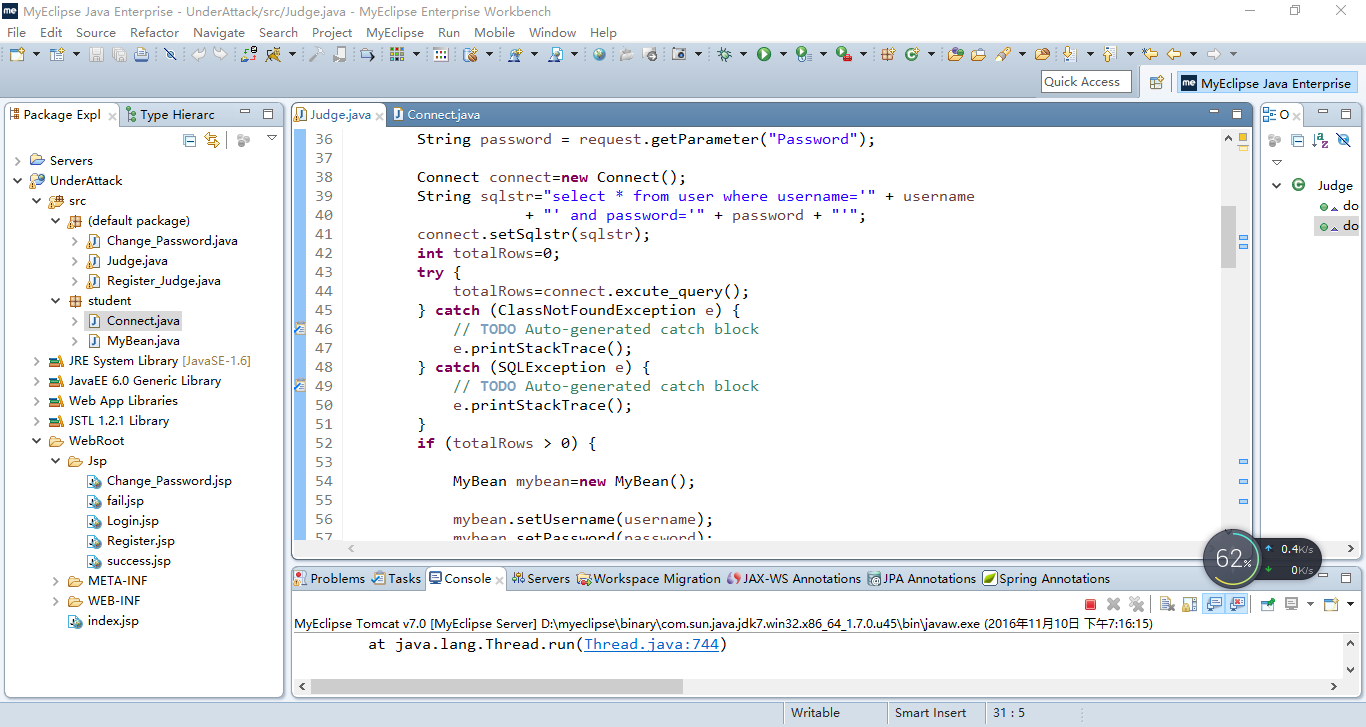
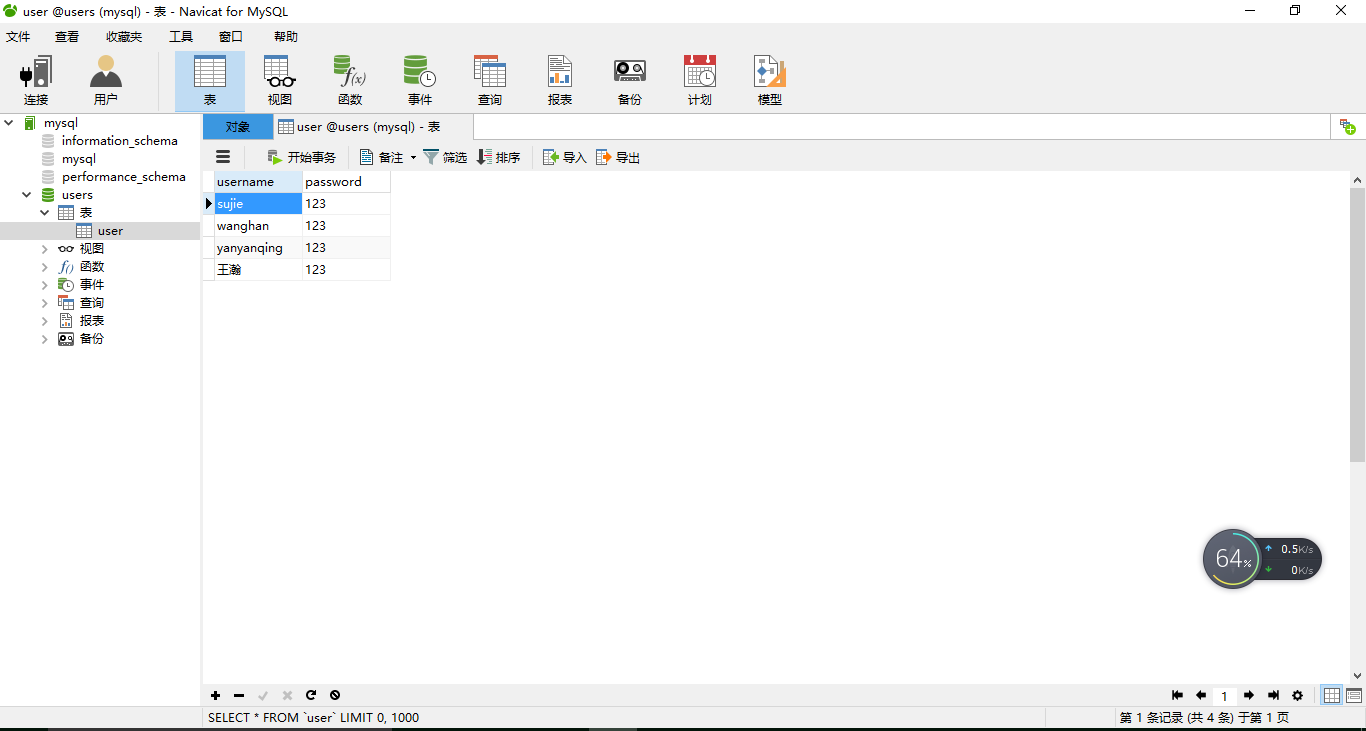
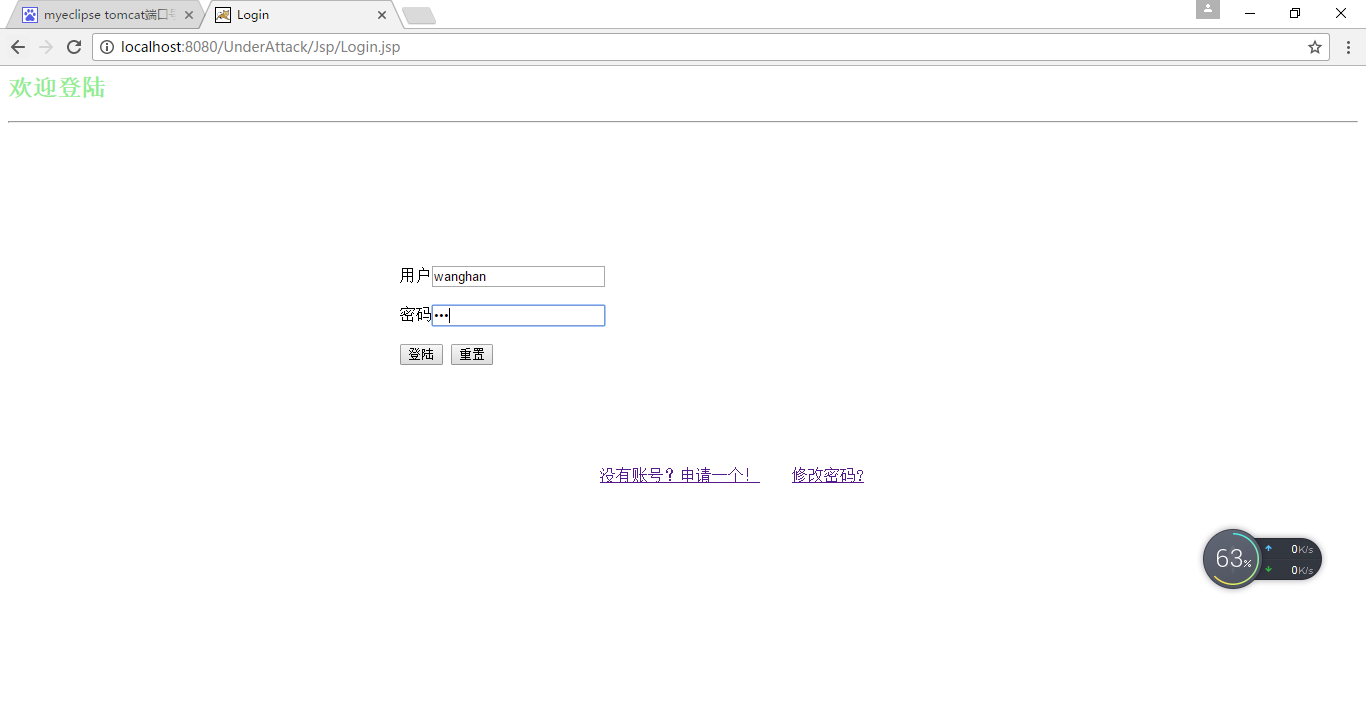



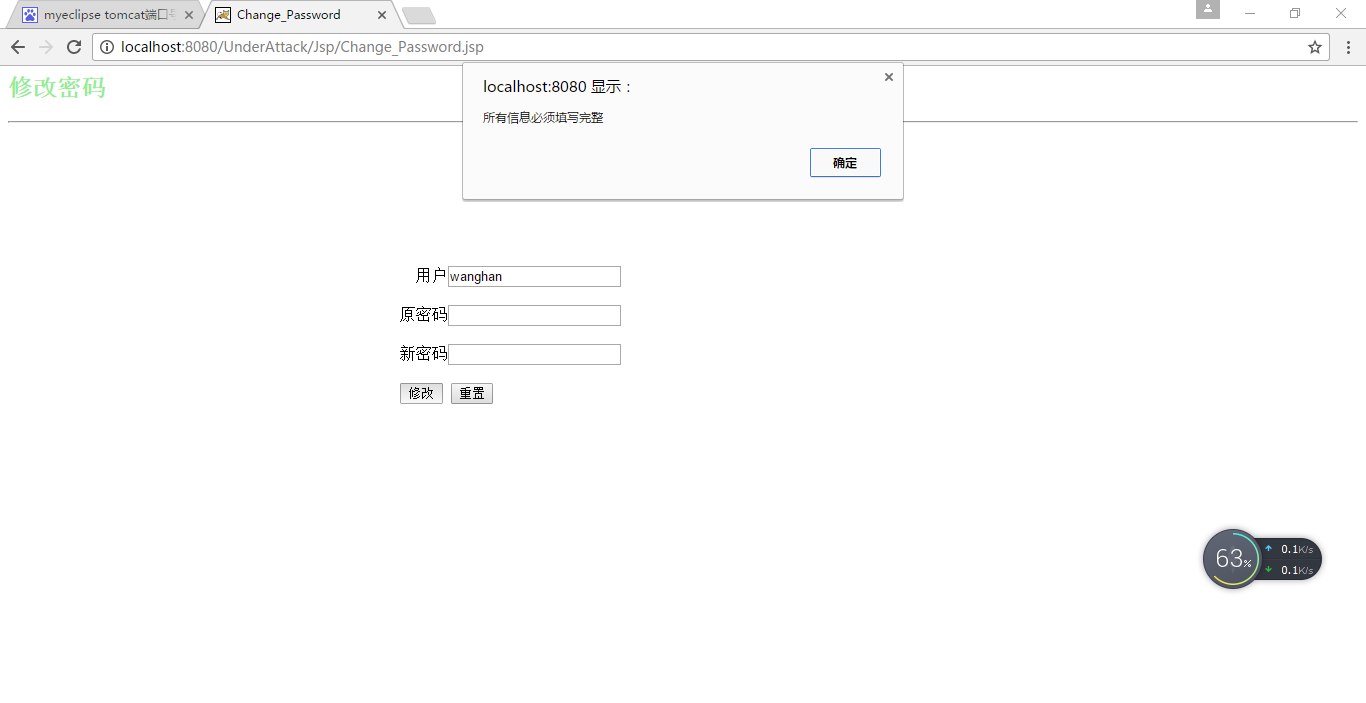


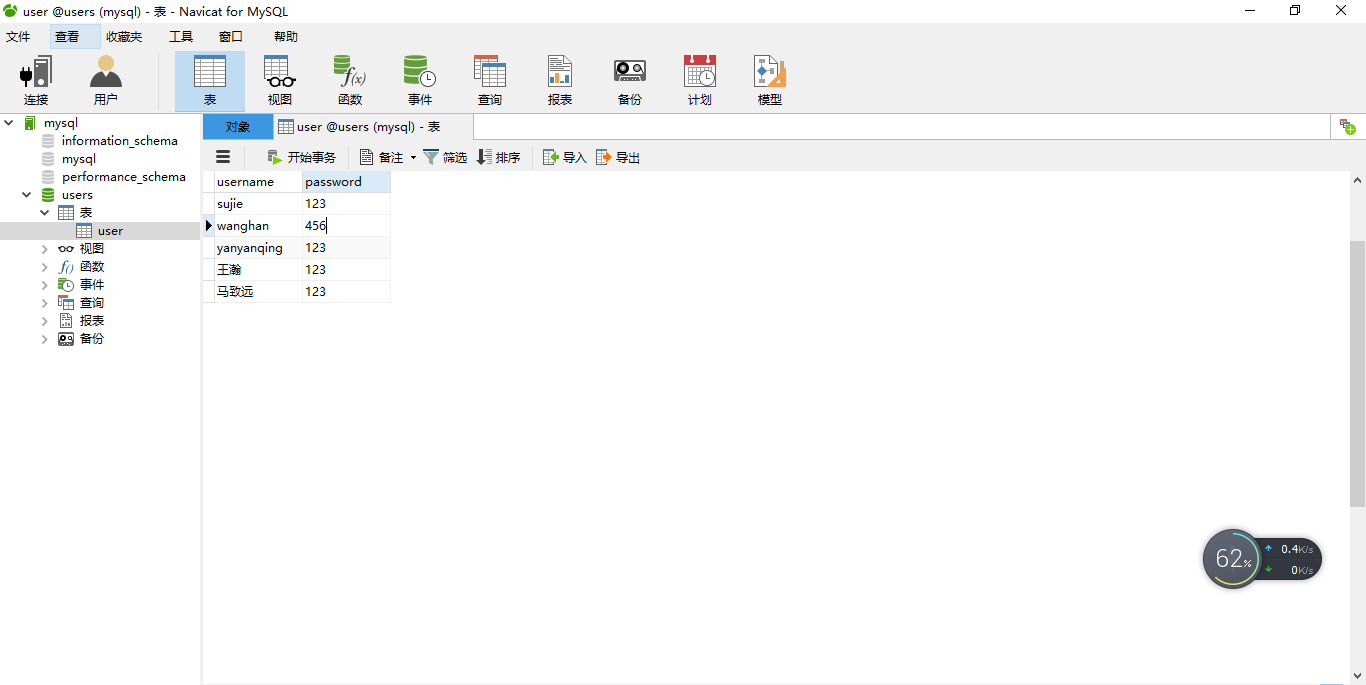














 2万+
2万+

 被折叠的 条评论
为什么被折叠?
被折叠的 条评论
为什么被折叠?








